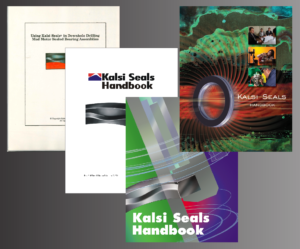
Retrospective
The newest revision of our rotary seal handbook was posted to our website on June 25, 2017. We thought this occasion would be a good time to look back through our company archives to review how it all began.
Sales of our initial high pressure seal design commenced in 1980s. Because of our technological leadership, we were awarded a Department of Energy research (DOE) grant in 1990. This grant allowed us to perform intensive laboratory testing to improve our understanding of how to implement our rotary seals in oilfield equipment.
As sales increased, we were spending more and more time helping customers implement the seals into their equipment. From our laboratory testing, we understood that high performance rotary seals require a well-engineered implementation for optimum performance. To help our customers engineer effective seal implementations, we began offering a series of technical notes in 1990. By early 1991, we had a product offering of 24 different sizes of rotary shaft seals — enough to warrant publication of a one-page chart of available off-the-shelf product sizes; the modest beginning of our first shaft seal catalog.
The genesis of our rotary seal handbook
In February of 1993, the size chart and eighteen technical notes were released in a three-ring binder as the book, “Using Kalsi Seals® in Downhole Drilling Mud Motor Sealed Bearing Assemblies”. This was a 0.7” (17.8mm) thick collection of technical information on how to implement Kalsi-brand rotary shaft seals into rotating equipment. Topics covered included gland design, seal carrier design, installation chamfer considerations, shaft hard coating considerations, assembly guidelines, seal breakout torque, lubricant selection, elastomer selection, venting characteristics of lip seals, and tips on designing sealed bearing mud motors. Although bearing a different name, this was the original genesis of the Kalsi Seal Handbook, and it was widely distributed in the 1990s.
As a result of DOE funding, we designed a mud motor sealed bearing assembly for research purposes, and used it successfully on actual drilling jobs in 1994. This gave us direct feedback on how mud motor seals performed in real-world downhole drilling conditions, and allowed us to provide better seal implementation advice in our published literature.
By the year 2000, the three-ring binder aspect of the book, and its black and white content, were looking dated, and the title and narrow focus of the book were no longer appropriate. Our seal product line had expanded beyond mud motor seals to include other high pressure seal products, such as swivel and RCD seals, and the book needed to reflect that.
The seal handbook becomes an integrated, chapter-based book
In January of 2001 we “caught a break”, so to speak, when the principal author of our seal technical literature shattered his leg, and was unable to come to the office for several months. He used his recovery time to collect and organize additional information about the use of our high-performance seals, and to create a variety of new color illustrations. This information was used to create the first edition of the “Kalsi Seals Handbook”. It was now an integrated, chapter-based technical handbook, rather than a collection of assorted technical notes.
Converting our seal handbook to an e-book format
In 2005 the handbook was updated, growing by an additional 42%. The larger it became, the more cumbersome it became to revise, and the more expensive it became to print and distribute. Later that decade, we began a multi-year undertaking to dramatically expand and reorganize our seal handbook, and convert it to an internet-based book with individually revisable chapters. The conversion was completed in 2012. The resulting ease of revision has allowed us to provide our customers with much more up-to-date information on our ever-evolving rotary shaft seal technology. The book now includes 57 chapters, covering such diverse topics as using our products as RCD seals, hydraulic swivel seals, washpipe seals, and mud motor seals. There are 21 separate chapters on various equipment engineering topics, and 19 chapters on the various types of high performance rotary seals we offer.
To learn more about the latest Kalsi Seal advancements, contact our highly experienced Seals engineering staff.
